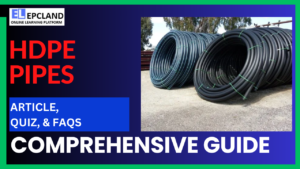1. Purpose of Pipe Sleeves
What is the primary purpose of a pipe sleeve?
Explanation: The primary purpose of a pipe sleeve is to enhance pipe strength, support, and protection against external factors.
2. Materials Used for Pipe Sleeves
Which material provides superior corrosion resistance for pipe sleeves in harsh environments?
Explanation: Stainless steel provides superior corrosion resistance, making it suitable for harsh environments in pipe sleeve applications.
3. Applications of Pipe Sleeves
How are PVC pipe sleeves commonly used in building applications?
Explanation: PVC pipe sleeves are commonly used for protecting cables and wires in building applications.
4. Benefits of Using Pipe Sleeves
How do pipe sleeves contribute to cost-effectiveness in the long run?
Explanation: Pipe sleeves contribute to cost-effectiveness by preventing costly repairs, downtime, and potential environmental damage caused by pipe failures.
5. Pipe Sleeve Applications
What is the purpose of using pipe sleeves when pipes need to cross roads, rails, or bridges?
Explanation: Pipe sleeves are used to protect pipes from heavy loads when they need to cross roads, rails, or bridges.
6. Pipe Sleeve Durability
Which material is known for its durability and resistance to wear and tear in pipe sleeves?
Explanation: Cast iron is known for its durability and resistance to wear and tear, making it suitable for pipe sleeves in underground applications.
7. Pipe Sleeve Safety
How do pipe sleeves contribute to improved safety in piping systems?
Explanation: Pipe sleeves contribute to improved safety by preventing leaks, reducing the risk of accidents, and protecting workers from potential hazards associated with damaged or exposed pipes.
Short Article on Pipe Sleeve
What is a Pipe Sleeve?
A pipe sleeve is a protective cover that is installed over a pipe to safeguard it from various external factors and potential damage. It acts as a barrier between the main pipe and its surrounding environment, providing additional strength, support, and protection. Pipe sleeves are commonly used in various piping applications, including industrial, commercial, and residential settings.
Materials Used for Pipe Sleeves
Pipe sleeves are made from a variety of materials, each with its unique properties and suitability for specific applications. Some of the commonly used materials include:
- Carbon steel: Carbon steel pipe sleeves are the most common type, offering a balance of strength, cost-effectiveness, and corrosion resistance.
- Cast iron: Cast iron pipe sleeves are known for their durability and resistance to wear and tear. They are often used in underground applications.
- Stainless steel: Stainless steel pipe sleeves provide superior corrosion resistance and are suitable for harsh environments.
- Copper: Copper pipe sleeves are commonly used in plumbing applications due to their excellent corrosion resistance and ductility.
- Nickel: Nickel pipe sleeves offer exceptional corrosion resistance and are often used in high-temperature applications.
- Aluminum: Aluminum pipe sleeves are lightweight and corrosion-resistant, making them suitable for applications where weight is a factor.
- PVC: PVC pipe sleeves are commonly used for protecting cables and wires, particularly in building applications.
- Rubber: Rubber pipe sleeves provide flexibility and vibration damping, making them suitable for applications where noise and vibration reduction are crucial.
- Composites: Composite pipe sleeves, such as FRP (Fiber-Reinforced Plastic) and GRP (Glass-Reinforced Plastic), offer high strength-to-weight ratio and corrosion resistance, making them ideal for buried piping systems.
Applications of Pipe Sleeves
Pipe sleeves find wide applications in various piping systems, serving diverse purposes and providing enhanced protection. Some of the common applications of pipe sleeves include:
- Protecting Pipes Crossing Roads, Rails, and Bridges: When pipes need to cross roads, rails, or bridges, they are often routed through pipe sleeves to protect them from heavy loads from vehicles and trains.
- Reinforcing Weak Sections of Pipes: Pipe sleeves can be used to reinforce weak sections of pipes, providing additional strength and support. This is particularly useful in areas where the pipe is subjected to increased stress or potential damage.
- Facilitating Hot Tapping Operations: Pipe sleeves are often used during hot tapping operations, where a branch connection is taken from an operating pipeline. The sleeve provides a secure and controlled environment for the tapping process.
- Insulating Pipes: Pipe sleeves can be used to insulate pipes, preventing heat loss and maintaining desired temperatures for the transported fluids.
- Repairing Pipes Temporarily: Pipe sleeves can be used to temporarily repair damaged pipes, preventing costly shutdowns and allowing for planned maintenance or replacement.
- Protecting Cables and Wires: PVC pipe sleeves are commonly used for protecting cables and wires, particularly in building applications, safeguarding them from mechanical damage and environmental factors.
- Supporting Buried Composite Piping Systems: In buried composite piping systems, spacers are often provided within pipe sleeves to support the pipe or pipeline, ensuring its stability and preventing deformation.
Benefits of Using Pipe Sleeves
Pipe sleeves offer a range of benefits that make them a valuable addition to various piping systems. These benefits include:
- Enhanced Protection: Pipe sleeves provide a protective barrier against external factors, such as physical damage, corrosion, and environmental exposure, extending the lifespan of the pipe and reducing the risk of leaks or failures.
- Increased Strength and Support: Pipe sleeves can reinforce weak sections of pipes and provide additional support, particularly in areas subjected to increased stress or potential damage.
- Facilitating Maintenance and Repair: Pipe sleeves can simplify maintenance and repair processes by providing easy access to the pipe or pipeline, allowing for quick inspection, repair, or replacement.
- Improved Safety: Pipe sleeves can enhance safety by preventing leaks, reducing the risk of accidents, and protecting workers from potential hazards associated with damaged or exposed pipes.
- Cost-Effectiveness: In the long run, pipe sleeves can be cost-effective by preventing costly repairs, downtime, and potential environmental damage caused by pipe failures.
Conclusion
Pipe sleeves play a crucial role in safeguarding and extending the lifespan of pipes in various applications. Their ability to protect against external factors, reinforce weak sections, and facilitate maintenance makes them a valuable investment for ensuring the integrity and reliability of piping systems
Table of Contents
Don’t miss the Course on Effective Isometrics Management: Check Now
Enrollment Link
Recommended courses (Published on EPCLand)
- Complete Course on Piping Engineering
- Basics of Piping Engineering
- Piping Layout Engineering
- Piping Material Engineering
- Piping Stress Analysis
- Material Requisitions
- Piping Material Specifications
- Valve Material Specifications
- Plant Design & Layouts-OISD 118
- Isometric Management
Library of Technical Articles
Don’t miss out the collection of 15+ articles on following topics:
- Basics of Oil and Gas Industry
- Valves
- Testing
- Tank
- Piping Bulk Items
- Pipe
- Metallurgy
- Piping Materials
- Layout
- Instrumentation
- Heat Exchanger
- Type of Contracts
- Codes and Standards
- ASTM Standards
- Articles on Piping Specialty Items
Video details of Complete Course on Piping Engineering
Why Enroll in the EPCLand
Proven Track Record– PTR
Activities & Achievements before launching EPCLand
- Published more than 50+ short courses
- 3000+ Enrolments
- More than 3,500,00 Minutes of watch hours in the last 2 years
- 4000+ Students in 100+ Countries
- Rating of 4+ out of 5
- 1000+ YouTube Videos
- 8K+ Subscribers
What Students will Learn
- Codes & Standards of the Energy Sector
- Piping Material Engineering
- Piping Layout Engineering
- Stress Analysis
Interesting facts
- All the published courses have been developed by Industry Experts with more than 2 decades of experience
- Content is based on Practical experience and real-time problems.
- Content is designed and organized in such a manner that it can be easily grabbed.
- Complete website, Blogs and Quiz sections are Planned, Designed and published by myself (About me: Atul Singla)
- Complete flexibility of Time & Location, Students can access the content from anywhere & anytime
- Moreover, once enrolled, the content can be access as many times as you want, which helps in understand the fundamentals in a better way.
Conclusion
In conclusion, our courses are meticulously crafted by industry experts with over two decades of hands-on experience. The content is rooted in practical knowledge, addressing real-time problems. The material is thoughtfully designed and organized for easy comprehension. Every aspect, from the website to blogs and quizzes, has been planned, designed, and executed by Atul Singla, ensuring a comprehensive and seamless learning experience. With the flexibility of accessing the content at any time and from any location, students have the freedom to learn on their terms. Furthermore, enrollment grants unlimited access, allowing learners to revisit the material as often as needed, fostering a deep understanding of the fundamentals.



